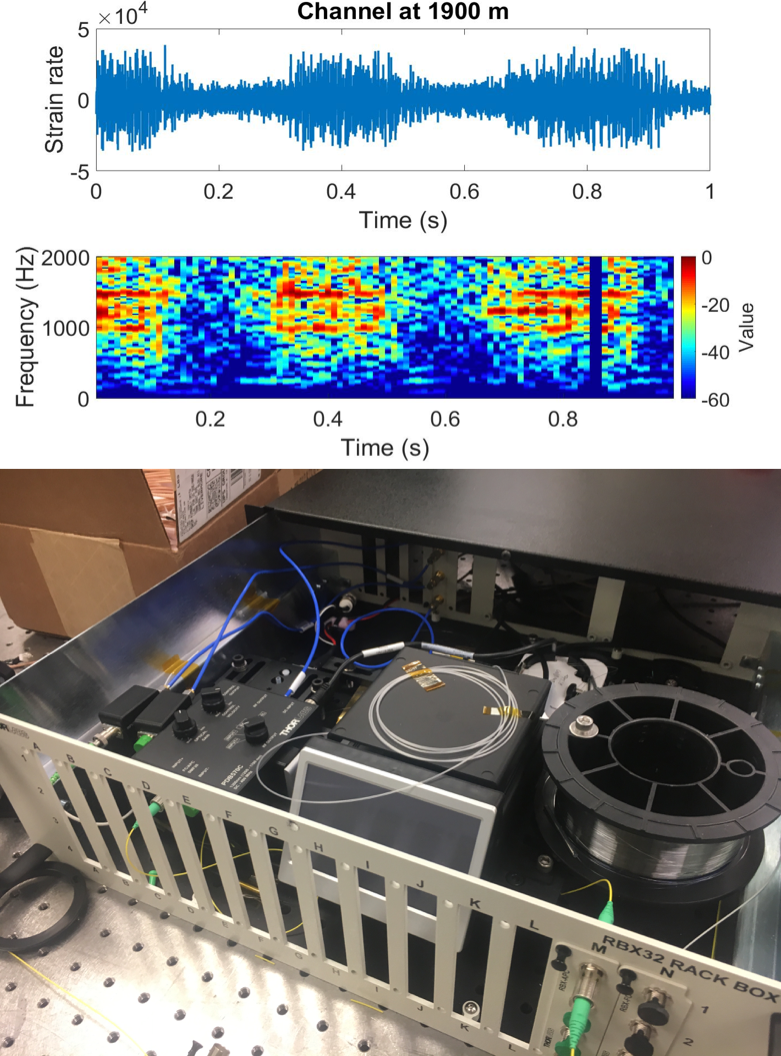Robert Mellors (17-ERD-015)
Executive Summary
We are developing subsurface fiber-optic sensors and advancing an underground computer-simulation code for monitoring hydraulic simulation of low-flowing oil and gas reservoirs. Remote sensing of subsurface phenomena is a continuing focus for various energy and national security concerns. Our research could enable improved energy applications in microseismicity and oil-and-gas bore-hole fluid monitoring, and benefit national security applications, including tunnel detection as well as explosion and port monitoring.
Project Description
Fiber-optic distributed acoustic sensors measure seismic and acoustic signals by measuring strain as a function of time at many (hundreds or thousands) of spatially distinct points using only the fiber itself as a sensor. Potentially useful for a wide range of applications, these sensors have a strong potential for improving understanding of the subsurface with applications in geothermal and oil-and-gas extraction, carbon dioxide sequestration, well-bore preservation, and nuclear waste disposal. For the sensor, an interrogator box sends laser pulses down the fiber, where unavoidable sub-micrometer imperfections backscatter small portions of each pulse as they pass through the fiber (Rayleigh scattering of light by particles in a medium). An interferometer inside the interrogator box compares the temporally smeared returned pulse to a reference beam and digitizes the result, yielding a trace of strain rate versus position at hertz to kilohertz rates, with high spatial resolution even over fibers as long as a few kilometers. The instrumentation is sufficiently sensitive to measure the transient strains produced by seismic and acoustic signals. The same types of fibers used for acoustic sensing can also be used to measure distributed temperature. We intend to improve utilization of well-bore datasets by coupling the data with the Laboratory’s advanced subsurface simulator (the GEOS hydraulic-fracturing simulation code) and developing improved sensors with fibers optimized for signal sensing. We intend to simulate the response of fiber-optic acoustic-sensor deployments, validate the predictions in ongoing field operations, and develop new custom optical fibers and hardware to resolve some of the existing limitations of this technology. Our initial focus will be on monitoring hydraulic simulation of low-permeability oil-and-gas reservoirs, but the technology can also be applied to other areas, including treaty monitoring, seismology, and tunnel detection. This research will also aid in validating the utilization of multi-scale, multi-physics modeling of subsurface engineering.
Remote sensing of subsurface phenomena is a continuing focus for a variety of energy and national security applications. We expect to incorporate and evaluate fiber-optic data in current unconventional oil and gas operations to develop new fiber optics for various applications through combined modeling and fiber synthesis. Advancing these applications requires both development of new subsurface sensors and establishment and validation of a relevant interpretational framework. We expect to provide enhanced simulation and interpretation capabilities along with the new fibers. Specifically, we intend to (1) validate the GEOS code using fiber-optic data provided by an independent oil producer, Pioneer Natural Resources of Irving, Texas; (2) model the source-to-signal of the strain at the sensor associated with various subsurface processing and fiber deployments using the GEOS code; and (3) model strain and sensor interactions and the design of optimized fibers. Source-to-signal simulation will be based on parametric modeling of subsurface reservoirs (such as for hydrocarbons and geothermal resources) that will provide an excellent opportunity to test the limits of fiber-optic monitoring and a variety of signals, including microseismic events, noise from fluid flow, and temperature. The parametric modeling will be coupled with a near-field fiber-response model. This task will utilize the GEOS modeling package to simulate the far-field processes and acoustic and strain signals that will be experienced in the near-field environment of fiber deployment. Development of novel fibers also requires simulation capabilities to enhance the performance of fiber-optic distributed acoustic sensors by addressing current limitations such as variations in azimuthal sensitivity and coupling. We will simulate and then experimentally test a variety of custom fiber designs and geometries that we believe can address existing challenges, including hollow-core fibers to ameliorate sensitivity to deployment conditions, multi-core fibers to provide enhanced directional sensitivity, and polarizing or polarization-maintaining fibers to enable more stable and accurate sensor long-term response. Our research could enable improved energy applications in hydraulic stimulation, microseismicity, and bore-hole fluid monitoring, whereas national security applications include border control and explosion and port monitoring.
Mission Relevance
Developing fiber-optic distributed acoustic sensor technology for understanding subsurface phenomena and creating geologic models supports the Laboratory's core competency in energy and resource security, which also addresses the DOE goal to strengthen key science, technology, and engineering capabilities and modernize the national security infrastructure. In addition to energy exploration, the proposed technology is also applicable to nuclear nonproliferation efforts in support of DOE/NNSA goals to reduce nuclear danger. Developing new fiber optics for various applications through combined modeling and fiber-optic synthesis supports the Laboratory's core competency in lasers and optical science and technology.
FY17 Accomplishments and Results
Our goals for FY17 were to acquire fiber optic data and model it with the GEOS code, as well as develop an in-house interrogator to test novel fibers. To this end, we (1) acquired fiber optic data from hydraulic-fracturing and geothermal projects; (2) created a set of strain models using GEOS that mimic fiber response from nearby fracture networks; (3) designed and acquired hardware for an in-house fiber interrogator; (4) began testing of the interrogator unit; and (5) initiated contacts with potential industry partners.
Publications and Presentations
Mellors, R.J. and C. Sherman, 2017. "Modeling of Borehole Fiber Optics in Response to Microseismic and Fracture-Related Strain." LLNL-PRES-735011.
Sherman, C., et al, 2017. "Simulating Fracture-Induced Strain Signals Measured by a Distributed Fiber Optic Sensor." SEG 2017 Annual Meeting. LLNL-CONF-728162.






